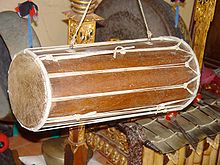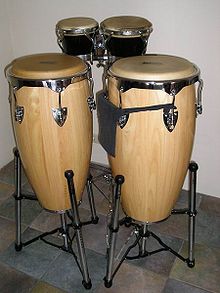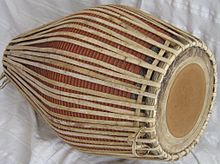User:Jacqke/Tubular drums

Tubular drum is a generic term for drums whose body is tubular according to the definition in the Hornbostel-Sachs system . The body can be covered with a membrane on one or both sides. In the first case, the underside remains open.
Cylinder drums have the same diameter over their entire length . They are distinguished from frame drums , the frame height of which corresponds at most to the radius of the membrane . This classification, based on practical reasons, refers to typical instruments. A format between cylinder and frame drum can be described as a flat drum , in which the frame height corresponds at most to the skin diameter.
Drums with a bulging body that curves outwards in the middle are called barrel drums ; they are tapered hourglass drums . Played standing on the floor, they are called standing drums .
The other type of drum is a closed-bottomed, one-skinned kettle drum (vessel drum) that includes the timpani .
Origin[edit]
In the Egyptian Middle Kingdom (from the beginning of the 2nd millennium BC), double-sided tubular drums are recognizable on numerous illustrations and are mentioned in texts. The larger ancient Egyptian drums were cylindrical and had an X-shaped lacing, a smaller type of drum was barrel-shaped with parallel lacing membranes. Their body was mostly made of wood, rarely made of bronze. The oldest cylinder drum found comes from a tomb in Beni Hasan and is believed to date from around 2000 BC. dated. In Mesopotamia , tubular drums are much less common at this time.[1]
Doubtful long cylinder drums have been common in Arabic military music since early Islamic times under the general Arabic term tabl ("drum"). Cylinder drums came to Europe with the Turkish Janissary music.[2] In the musicological work Syntagma musicum by the composer Michael Praetorius from 1619, the tubular drum is still shown as a musical instrument of the Orient.
Classification by type[edit]
The Hornbostel-Sachs system classifies tube drums based on their design.

Cylinder drums[edit]
Cylindrical drums, like the tom-tom played in modern drum sets , the snare drum and the bass drum, are made of bent and glued laminated wood panels (occasionally plastic) or hollowed out of a section of trunk wood using the method known since pre-Christian times. The clear cylindrical shape of drums made in this way is relatively rare. It comes with the great Turkish military drum davul and its related tapanin the Balkans. Even if these should be frame drums according to their height to diameter ratio, they are classified as cylinder drums according to their origin from the long military drums. Cylindrical drums include drums that are widespread or only used in a specific region:
Alfaia , lightweight plywood Brazilian bass drum Caixa , snare drum in Brazilian samba and other styles of dance music Chande , in south Indian Karnataka folk music , especially in the Yakshagana dance drama Chenda , similar to the chande , in the southern Indian state of Kerala Dammam , used to accompany Shia mourning ceremonies in Iraq and Iran Doli , wooden drum in popular music of Georgia Dunun , wooden cylinder drum played with sticks in West Africa Lambeg drum , large cylinder drum played with sticks at street parades in Northern Ireland Pambai , two linked wooden cylinder drumsplayed in religious music in the Indian states of Andhra Pradesh and Tamil Nadu Tabor , historical cylinder drum since the European Middle Ages, which a musicianplays at the same time as a one-handed flute T'bol , collective names for cylinder drums in the Maghreb Yak bera , used in rituals in southern Sri Lanka
Barrel drums[edit]

Barrel drums carved from a block of wood or molded from plastic are known in large numbers. The two outer diameters can be different, resulting in two pitches. In addition to the South American, one-headed conga , round-bellied barrel drums include:
Atsimevu , leading drum in the large Ewe drum orchestra in Ghana, whose beat is provided by the gankogui handbell Buk , dubious barrel drum in Korean folk music Dhimay , barrel drum in the Kathmandu Valley of Nepal Dhol , large, double-headed barrel drum in northern India Dholak , smaller than the dhol , from northern India to Afghanistan Dholki , similar to the dholak , in western and eastern India Ghoema , single-headed drum beaten with the hands, mainly used at the New Year celebrations in South Africa Kendang , group of dubious Indonesian barrel drums Negarit , ancient Ethiopian war drum whose namederives from naqqara , a common type of cauldron drum, which in some regions also includes barrel drums Taiko , group of large double-headed, vertically played barrel drums in Japan Tavil , South Indian barrel drum
Cone drums[edit]
The diameters of both sides are significantly unequal. The body has the shape of a truncated cone, in length it runs almost straight.
Samel , wooden drum in the Indian state of Goa
Double cone drums[edit]

Double cone drums have a larger central diameter, the body tapers in a more or less straight line to the ends. Such a clearly visible kink in the middle is found mainly in double-headed drums played in a horizontal position in India:
Khol , in North and East Indian religious folk music Maddale , in Karnataka folk music Mridangam , in South Indian classical music Pakhawaj , in North Indian classical music Pashchima , folk music of the Kathmandu Valley of Nepal Pung , particularly slender form for dance accompaniment in the north-east Indian state of Manipur
Hourglass drums[edit]

The middle diameter is smaller than the two end diameters. Some African speaking drums with cord tension that can be changed while playing are hourglass-shaped. In Asia, this drum shape is often associated with a religious meaning. The damaru played in India and in Tibetan music is one of the attributes of Shiva and other gods in Indian mythology , and the idakka played in the temple music of Kerala is worshiped accordingly .
Batá drum , Afro-Cuban hourglass drum with differently sized heads Daunr , small wooden hourglass drum in the Garhwal region of India on the southern edge of the Himalayas Dhadd , small wooden hourglass drum used primarily by Sikhs in the north-west Indian state of Punjab Hurka , slightly larger than the damaru , in the Garhwal and Kumaon regions Janggu , in Korean music Jiegu , historical hourglass drum in China Kalangu , dubious hourglass drum of the Hausa people of West Africa Kundu , hourglass drum in the music of New Guinea . The wooden water drums on the Sepik River in north-eastern New Guinea are also hourglass-shaped and once of great mythological importance. Timila , like the idakka used in Kerala's temple music
Goblet drums[edit]

The body of the drum is cauldron-shaped or cylindrical and merges into a slimmer base. Goblet drums are single-skinned, they either have a closed body base or are open to the foot end. They are often held between the knees or tucked horizontally under the arm and beaten with both hands. Very large types have a stand with which they stand on the ground.
Bekiviro , roughly man-high ritual drum played in possession rituals on the west coast of Madagascar Dabakan , used in the Philippines, with a turned and ornamented wooden body Darbuka , typical mug drum in the Middle East and North Africa Djembé , widespread in West Africa, membrane mostly with cord tension Ozi , ritual drum in Myanmar from one to three meters in length Tombak , also zarb , in classical and folk music of Iran Zerbaghali , clay goblet drum played in folk music of Afghanistan
Classification according to purpose or style of play[edit]
Drums beaten with mallets or brushes can be distinguished from hand drums . Stand drums that are only struck on one side often have a second skin on the underside. This allows the upper skin to be stretched, and at the same time it serves to enhance the resonance. In medieval military music there were long, cylindrical, double-headed snare drums (also Landsknechttrommeln ), today the name derived from the circular movements of the beaters or brooms is used synonymously for the single-headed snare drums .
Itemization[edit]
Hans Hickmann : The ancient Egyptian tubular drums. In: Oriens, Vol. 17, December 31, 1964, pp. 172-181, here p. 173
Hans Hickmann: The music of the Arabic-Islamic area . In: Bertold Coiler (ed.): Handbook of Oriental Studies. 1st Dept. Near and Middle East. Supplementary Volume IV. Oriental Music. EJ Brill, Leiden/Cologne 1970, p. 62 Jim Sykes, Musical Knowledge and the Vernacular Past in Post-War Sri Lanka. ISA, 2012, pp. 1–12, here p. 3
- ^ Hickmann, Hans (31 December 1964). "Die altägyptischen Röhrentrommeln". Oriens. 17: 173.
- ^ Hickmann, Hans (1970). "Die Musik des Arabisch-Islamischen Bereichs". In Bertold Spuler (ed.). Handbuch der Orientalistik. 1. Abt. Der Nahe und der Mittlere Osten. Ergänzungsband IV. Orientalische Musik. Leiden/Köln: E.J. Brill. p. 62.
- ^ Jim Sykes: Musical Knowledge and the Vernacular Past in Post-War Sri Lanka. ISA, 2012, S. 1–12, hier S. 3
